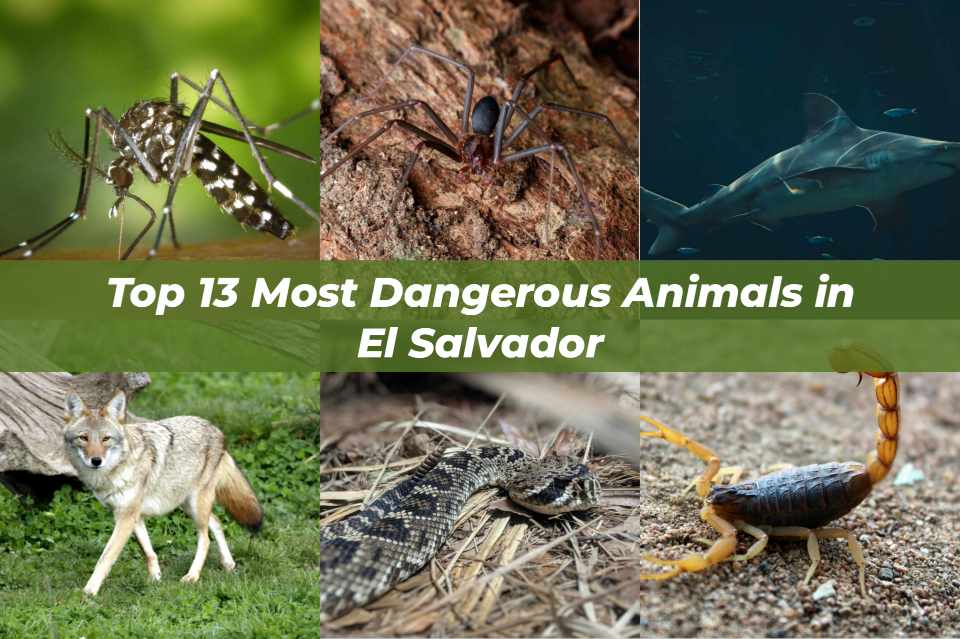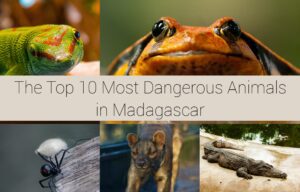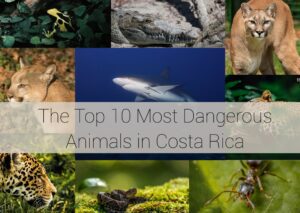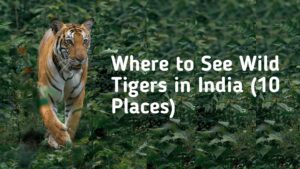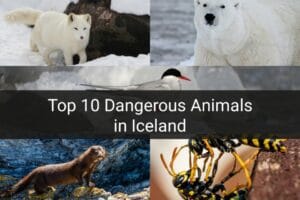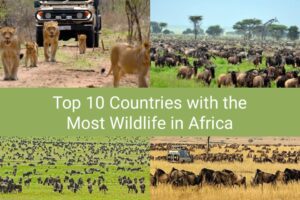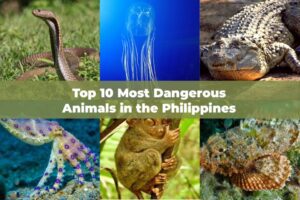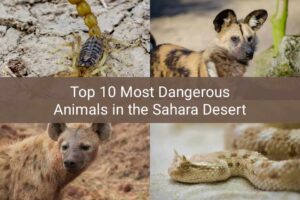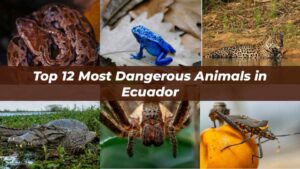El Salvador is one of the most popular tourist destinations in Central America. This country is known for its diverse wildlife and rainforests.
Just like many other countries, El Salvador is home to some animals that you may consider dangerous, mainly because of their venomous or poisonous nature. Some animals are known as apex predators in their natural habitats, and they can be threatening to other animals and sometimes humans.
In this article, we will look at the top 13 most dangerous animals in El Salvador. You will also learn about these animals and discover why they are considered dangerous.
Top 13 Most Dangerous Animals in El Salvador
1. Boa Constrictor

Scientific Name: Boa constrictor
Boa constrictors, also known as common boas, are large non-venomous snakes native to South America. They have powerful muscles which they use to constrict prey.
What makes the boa constrictor dangerous is its method of hunting and subduing prey. Since boa constrictors are ambush predators, they lie motionless for hours waiting for prey to come along, then they attack with lightning speed.
These snakes consist entirely of muscle, and their coils are known to stop blood flow, leading to death by cardiac arrest or asphyxiation.
Large boas are strong enough to stop a human heart or even break the bones of smaller animals.
Adult boa constrictors can grow over 10 feet and weigh more than 60 pounds. Their body size allows them to consume large animals like monkeys, pigs, or deer.
In El Salvador, boa constrictors can be found in dense tropical forests and sometimes near agricultural fields.
2. Fer-de-Lance

Scientific Name: Bothrops asper
The Fer-de-Lance is a highly venomous pit viper found in El Salvador. This is the most venomous snake in El Salvador and Central and South America.
Locals call this snake Terciopelo; it is the most feared snake in El Salvador.
The Fer-de-Lance snake has a potent hemotoxic venom that causes intense pain, swelling, internal bleeding, and blood clotting problems. A bite can be life-threatening or lead to permanent disability if proper medical treatment is not provided immediately.
Their patterns and colours make them difficult to spot in leaf litter or under forest cover, where they lie and wait to ambush prey.
In El Salvador, Fer-de-Lance snakes are found in rainforests, agricultural areas like coffee and banana plantations, and near rural villages.
Interesting fact
Female Fer-de-Lance can give birth to over 60 live young at once. This makes them widespread and harder to control in the wild.
As a traveller who is going to explore forest areas, it is always advisable to wear strong closed-toe shoes or boots.
3. American Crocodile

Scientific Name: Crocodylus acutus
American Crocodiles are large apex predators found in coastal areas, mangrove swamps, estuaries, and some rivers. These crocodile species have powerful bites and attack both aquatic and terrestrial animals.
A large adult American Crocodile can reach 13 feet in length and can attack fully grown cattle. Their diet includes various birds, mammals, turtles, snakes, lizards, smaller crocodiles, crabs and fish.
You do not want to be in the same waters with these creatures. Places like the Jiquilisco Bay Biosphere Reserve are known crocodile habitats in El Salvador.
4. Spectacled Caiman

Scientific Name: Caiman crocodilus
Another dangerous animal found in El Salvador is the Spectacled Caiman also known as the white caiman, common caiman, or speckled caiman.
These predators are often mistaken for American crocodiles, but they are smaller, with males being both longer and heavier than females.
Spectacled caimans have powerful jaws and razor-sharp teeth that they use to tear the flesh of prey. They can become aggressive and territorial and move rapidly when threatened.
Although Spectacled Caimans prefer to hunt at night, they can still pose a risk during the day. Their diet includes snails, freshwater crabs, fish, small mammals, lizards, and so on.
In El Salvador, you can find spectacled caimans in areas like the lower Lempa River, Lago Guija, Laguna de Olomega, Laguna El Jocotal, and Humedales.
5. Coral Snakes

Scientific Name: Micrurus species
Coral snakes are one of the most venomous snakes in El Salvador and North America. Their venom can cause muscle weakness, paralysis, difficulty breathing, speech and vision problems.
Although coral snakes are less aggressive than pit vipers like the Fer-de-Lance, their venom is highly toxic. A bite will lead to a serious medical emergency.
The worst part is their appearance, which closely resembles non-venomous snakes known as milk snakes.
The rhyme “Red on yellow, kill a fellow. Red on black, venom lack (or friend of Jack)” is used to distinguish venomous coral snakes from other non-venomous mimics.
According to this rhyme, the red and yellow banding touch on venomous coral snakes, while the red and black banding touch on non-venomous snakes.
Coral snakes love to burrow into the ground in forested areas, in leaf litter, under logs, or in loose soil. They are quite secretive and prefer to move around at night.
Encounters with humans are rare as compared to other snakes in the region. However, they can sometimes be found in gardens or agricultural land.
Their primary food sources are smaller snakes, lizards, frogs, nestling birds, and small rodents.
6. Africanized Honey Bees

Scientific Name: Apis mellifera
Africanized Honey Bees are also known as killer bees. These are hybrids of European honey bees and African honey bees.
Africanized Honey Bees are known for their aggressive defensive behaviour, which can be dangerous. They are known to chase intruders for longer distances and in greater numbers.
Imagine receiving multiple stings from these guys while still running from them. It can be very dangerous, even life-threatening, due to the amount of venom injected.
If you have bee sting allergies (anaphylaxis), stay cautious of these bees when in the wild. Even other animals can be affected by Africanized Honey Bees.
7. Neotropical Rattlesnake

Scientific Name: Crotalus durissus
Neotropical Rattlesnake are another venomous pit viper to be aware of in El Salvador. These snakes are also known as cascabel by locals.
The venom of a Neotropical Rattlesnake often contains both neurotoxic and hemotoxic components. A bite can cause blurred vision, temporary blindness (or complete blindness), muscle weakness or paralysis, difficulty breathing, and blood clotting issues.
It prefers dry and open habitats like dry forests, scrublands, rocky areas, and sometimes on farmland.
Whenever you see a snake with a rattle at the end of its tail or if you suddenly start to hear a rattling sound, locate the source of the sound and then back off slowly.
8. Scorpions

Order: Scorpiones
Scorpions are popular for their painful stings. These tiny creatures have a venomous sting which is mostly painful but can be dangerous to children or the elderly. Locals call it the alacrán.
A sting from a scorpion will cause intense pain, burning, numbness, swelling, sweating, and even muscle twitching and breathing difficulties.
Scorpions are more likely to hide in cool, dark places like under rocks, logs, or in shoes, clothing, or bedding. This is why you should always shake out your shoes, clothes, and beddings before use, especially if they have been on the floor or outdoors.
9. Giant Centipede

Genus: Scolopendra
Giant centipedes are not your normal centipedes you find in some places; these species can grow to be very large. They are also known for their very painful bite.
Giant centipedes use their modified front legs called forcipules to inject venom into prey. This venom causes intense and long-lasting pain and swelling.
The largest giant centipedes in the wild exceed 12 inches in length, making them the largest living centipedes in the world.
In the wild, you will find them under logs, rocks, leaf litter, and in rotting wood. Just like scorpions, giant centipedes can sometimes enter houses, especially in forested areas.
Their speed allows them to disappear into hiding in the blink of an eye.
10. Black Widow Spider

Genus: Latrodectus
Black Widow Spiders are one of the common spider species in El Salvador. They are known for their venomous bites, which can become fatal in some cases.
A bite from the black widow spider can cause severe muscle pain and cramping, nausea, tremors, and difficulty breathing. It can also become extremely unpleasant and require medical attention in some cases.
They have an iconic shiny, black body with a striking red hourglass symbol on their underside.
11. Coyote

Scientific Name: Canis latrans
Coyotes are also known as American jackals, prairie wolves, or brush wolves. They are a species of canine native to North America.
Although coyotes might not be in the same category as snakes or crocodiles, they can be dangerous. Known for their cleverness and adaptability, coyotes hunt large prey like deer and other animals like rabbits, hares, rodents, birds, reptiles, and fish.
Just like dogs, they can also eat fruits and vegetables. They are also known to attack farm animals like goats, sheep, and cows.
12. Bull Shark

Scientific Name: Carcharhinus leucas
Bull Sharks also known as Zambezi sharks in Africa, are species of shark found in warm shallow waters around the world.
These sharks have the ability to survive in both salt and fresh water. Bull sharks are one of the most popular shark species, depicted in movies as being very dangerous even to swimmers.
As an apex predator, bull sharks prey on bony fish, other small sharks, dolphins and stingrays.
13. Mosquitoes

Scientific Name: Culicidae
Mosquitoes are common on almost all continents and are famous for their bite, which can transmit diseases. They are known to carry diseases like dengue fever, Zika virus, and chikungunya.
In El Salvador, mosquitoes are common, especially during the raining seasons. Most mosquitoes are active during the day and at night.
The best way to prevent mosquito bites is to use effective insect repellent that contains DEET, picaridin, or oil of lemon eucalyptus. You can also wear a more covered outfit and a mosquito-treated sleeping net in local accommodations or places without screens.
Bonus
Brown Recluse Spider

Scientific Name: Loxosceles reclusa
Brown Recluse Spiders are among the venomous spiders in El Salvador. Their venom is potent enough to damage tissue and red blood cells.
A bite might start small but can develop into a non-healing wound that can take months to heal.
Although Brown Recluse Spiders are venomous, they are rarely aggressive, and bites happen less often unless provoked.
Conclusion
El Salvador is a great travel destination for many travellers who want to explore the wildlife and local forests. In this article, we have provided a list of the top 13 most dangerous animals in El Salvador and a bonus.
Notice most of these animals are snakes and forest-dwelling animals; this is because El Salvador is located in an area dominated by tropical rain forests.
FAQs
Are there crocodiles in El Salvador?
Yes, there are crocodiles in El Salvador. The American crocodile and other species are found in the lower Lempa River, mangrove swamps, and parts of the Barra de Santiago.
Is it safe to swim in El Salvador?
It is safe to swim in El Salvador for places with low aquatic predators like crocodiles. You should be fine if you are with a local guide.
Are there any animals that are dangerous but are not among the top 13?
Yes, many other animals can be dangerous in El Salvador. Animals like stray dogs can be a concern due to bites or rabies, and some marine animals like jellyfish or stingrays can also cause painful stings at the beach.

Hi, I’m Louis Ojibe, and I grew up around wildlife in Africa. I have always been fascinated by animals and nature across the world.
As a child, my parents used to take me to see wild animals like lions, elephants, gorillas, tortoises, and many others at our local zoo.

